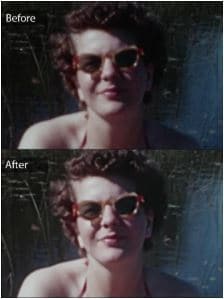Bear with me as I relate a brief true story.
One of the projects I decided to take on during the enforced hiatus of our global pandemic is to go through my Dad’s old slides to digitize them. The first box of slides I received was mostly a bust – a lot of pics of buildings and people I did not recognize. But among the chaff were several of potential grains of wheat – three 25-foot reels of 8 mm home movie.
This was a real mystery to me since we never owned an 8 mm camera when I was a kid. I had no idea what was on the film (8mm is wicked tiny). The date of processing gave a small clue. Two of the reels were processed in 1953 and the other in the fall of 1952. My parents were married in June of 1952, so there was a chance that it included footage from their wedding. Otherwise the reels were a black box.
I found a company online that could process the film into a digital format. There were many options regarding dpi and enhancement etc. I opted for the middle alternative for all choices, sent it off and looked forward to seeing what would come back with expectations held in check.
A couple weeks later I received an email from Brad, the tech processing the film. He wanted to know if I wanted to upgrade the quality of the processing and included a single frame from one of the reels showing the image using the quality I had requested (before) compared to how it would look with more extensive digital enhancement (after) – at a somewhat higher price, of course.
Here are the two images:
 I was stunned into silence by the pics. They show my mother – at her movie-star best – when she was 22 years old, two years before I was born.
I was stunned into silence by the pics. They show my mother – at her movie-star best – when she was 22 years old, two years before I was born.
- Did I want the better processing?
- Of course I did! My Mom passed away 12 years ago. To see this image of her, so young and vibrant, was amazing – and to see her in action will be even more so.
- Is the admittedly small difference in quality worth it?
- Absolutely! I want to be able to see every nuance and detail of her facial expression and movement. I have tons of still pics of her, but nothing in action.
- Did I feel manipulated by the tech?
- A bit, yes.
- Do I care?
- Not in the least. I can’t wait to see the completed project.
What does all this have to do with hearing care?
The interaction I had with this tech highlights two concepts critical to counseling regarding amplification:
- Don’t tell – show
- Make an emotional connection
In trying to convince me to upgrade to the enhanced processing, Brad could have explained the technology behind the enhancements and told me how many dpi the advanced technique would yield compared to the level I had initially chosen. Instead, he showed me. The difference between the images was subtle, but important to me because it will allow me to see my mother as I have never before seen her.
How often do we counsel our patients regarding differences in hearing aid technology by throwing technical jargon and explanations at them rather than expressing how their lives will be improved by one feature or level of technology versus another – specifically? This is benefit.
The best way to demonstrate benefit is for the patient to experience it for themselves via in-office demo or a trial period of use in the real world. Don’t tell – show.
It is also important that we make an emotional connection and understand our patients’ emotions around their hearing loss. Doing so can seem manipulative. But it makes the consequences of their decision very real to them. Explaining to your patient that use of hearing instruments will help them to better hear female and children’s voices and to understand in noisy situations, in the abstract, is one thing. But describing how they will be able to understand their grandchildren once again, to resume interacting with friends at coffee fellowship after church or to be able to fully experience their daughter’s upcoming wedding, is completely different.
I had no idea what it would mean to me to see my mother (and who knows who and what else!) in the home movies I sent off to be digitized. Similarly, our patients have no idea what they are missing due to the gradual progression of their hearing loss. I am grateful that Brad showed me what I would be missing and illustrated it with a magical picture of my mother. He did not sell me an upgrade. Rather, by showing me how an upgrade in technology would be more fulfilling, he gave me an opportunity to enhance my life and the lives of my mother’s grandchildren with a precious keepsake. When we demonstrate to our patients the benefit of higher technology hearing instruments, we offer our patients no less.






